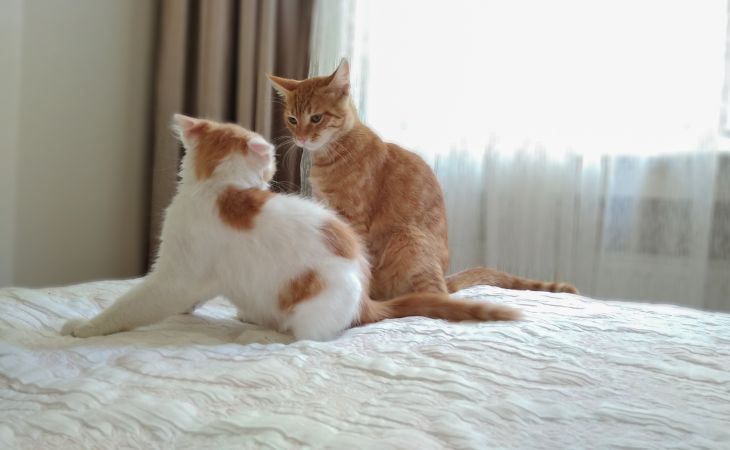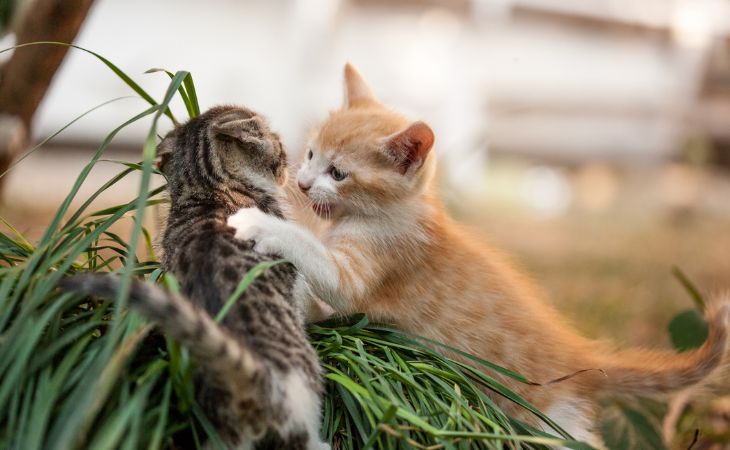If you have more than one cat, it can be difficult for them to live together harmoniously. It can also be difficult to understand the difference between cats playing and fighting. In this article, we will share a few things to look out for to recognize if cats are fighting.
How to recognize when cats are playing?
Cat fights can just as much be about dealing with disagreements as they are about having fun. Cats attack and kick each with their paws, even when they play. It can be confusing to interpret these types of situation. However, it is possible to succeed in understanding your cats by observing their posture and their behavior.
The attitude of cats that are playing
The most revealing factor of cats playing instead of fighting is silence. Cats do not make a lot of noise when they play. In other words, they do not hiss at each other. Their game is rather silent. In addition, different aspects of their body language will show that they are playing. For example, their ears will be pointing forward, their fur will not standing on end, and their claws will not be out. When playing, cats can provoke their playmate with little leaps, jumping directly on the other before rolling together in a ball on the floor and following each other all over the house.
In addition, when playing, their position changes often. They might start by standing with their backs arched, then lie down on the ground wiggling their back, ready to leap, and finish by playing with their paws in the air. The one that invited the other cat to play might find themselves in the inverse role. In addition, cats are easily distracted. Whether that be by their owner or by their environment. You might notice, as well, that they take a lot of breaks. It can be to lick themselves, or to prepare for their next attack in order to start playing again.
The importance of playing for cats
From a very young age, playing becomes a way for kittens to learn. This come from their natural instincts as hunters. Playing is also necessary for their sociability with others within the same household. Kittens that are four weeks old often fight with their siblings to determine the hierarchal order.
As they grow older, around 8 weeks, their predatory nature pushes them to play. They can play alone with small objects, or by challenging an older cat. However, if the older cat is not willing to play, they can become impatient and try to teach their little cat friend a lesson. Training to hunt, even for apartment cats or cats who go out very little, is also important. In the wild, cats need to be able to feed themselves, by catching prey with their own prowess.
However, playing, notably with objects, is also a way to reduce stress and fear in cats. It’s a way to establish trust with their owner and other cats and dogs. For indoor animals, playing allows them to prevent boredom. If they do not get hurt or put themselves in danger, you can let them play without worrying.
How to recognize when cats are fighting
Fights between cats are not always friendly. Some can seem so, at first, and then end up being violent.
Body language during a cat quarrel
It’s easy to decrypt a cat’s body language during a cat fight. For example, cats will stare, circling each other menacingly, often standing off to the side rather than facing each other directly. Additionally, their ears will be turned back, flat against their head. When it comes to their eyes, the pupils will be more dilated than if they were just playing. Their fur will be standing on end, making it look like they have more volume. If you look at their tail, you will notice that they are moving it around quickly.
During a cat fight, their claws will be out, either to be ready to attack or to defend themselves. One major difference between cats fighting and playing is that cats are very loud during a cat fight. For example, they will be hissing and making loud noises. They will also try to intimidate the other cat before attacking. Because they are so concentrated on one another, nothing will be able to distract them. If you try to intervene to separate them, it is highly likely that they will ignore you. Cat fights are quick and aggressive, and can lead to biting and scratches that can sometimes be severe.
Why do cats fight?
To begin with, cats are territorial animals. The first cat to arrive in the household will want to assert their dominance in their area. When strangers, such as a new cat, come onto their territory, it can make them aggressive at first. It will take time for them to establish their place in the household. Cases like this can also generate a lot of anxiety in cats who consider themselves as owners of the house.
Conflicts can start for other reasons as well. For example, mating season makes competitors in search of mates on edge. In addition, a cat who is in pain will be particularly grumpy if another cat tries to annoy them. Another reason why cats might fight is because they smell an odor that they associate with an unpleasing event. For example, this might be from a vet visit or the search for hierarchal status within the household.

What should you do when faced with a cat fight?
We can sometimes feel helpless when faced with cats fighting. In most cases, it is not recommended to intervene.
At what point should you intervene when cats are fighting?
As soon as you are certain that your cats are not playing, it’s important to analyze the situation before stepping in. If you intervene, the problem between them will not be solved and they will surely try to fight again. You could also risk getting scratched or bitten. In an effort to distract the cats, you can try to make loud noises. Sometimes, this works and the cats will separate themselves on their own.
However, most of the time, they will ignore you as they are too focused on one another. To prevent any injuries, you can try to create a barrier. You can do this with some cardboard, for example. It is important to never make a barriers with your hands. If you do this, you could risk getting attacked and hurt. Stay wary and alert. If they start to calm themselves, try to distance them from each other for a moment. This will allow you to have the time to prepare yourself to avoid any future fights.
Solutions to limit fighting between cats
If you have adopted another cat, it’s best to present the new cat to your other cat in steps. In addition, keep a barrier close by so that you can separate them easily at the slightest hiss. With that being said, it’s also important to let them try to get to know each other. If things are not running smoothly, you can place the new cat in another room away from your other cat.
In order to prevent your cats from fighting over their territory, you can help them outline their own designated area. At first, it’s best to avoid having the cats share the same food bowl. Each cat needs their own belongings. This can be the place where they eat or their toys. If your cat is interacting with the new cats in a tolerant and friendly manner, consider rewarding them with a treat. It is easier for cats to share their living space if they are able to find their bearings.
Neutering is also a good way to calm down the atmosphere between cats. The reproduction period will no longer be a cause of conflict to know which cat dominates and rivals the other. If you are in the presence of a wounded or sick cat, keep them isolated from the other cat so that they are not bothered. With patience and observation, you will be able to create an environment of trust and peace in your household.

